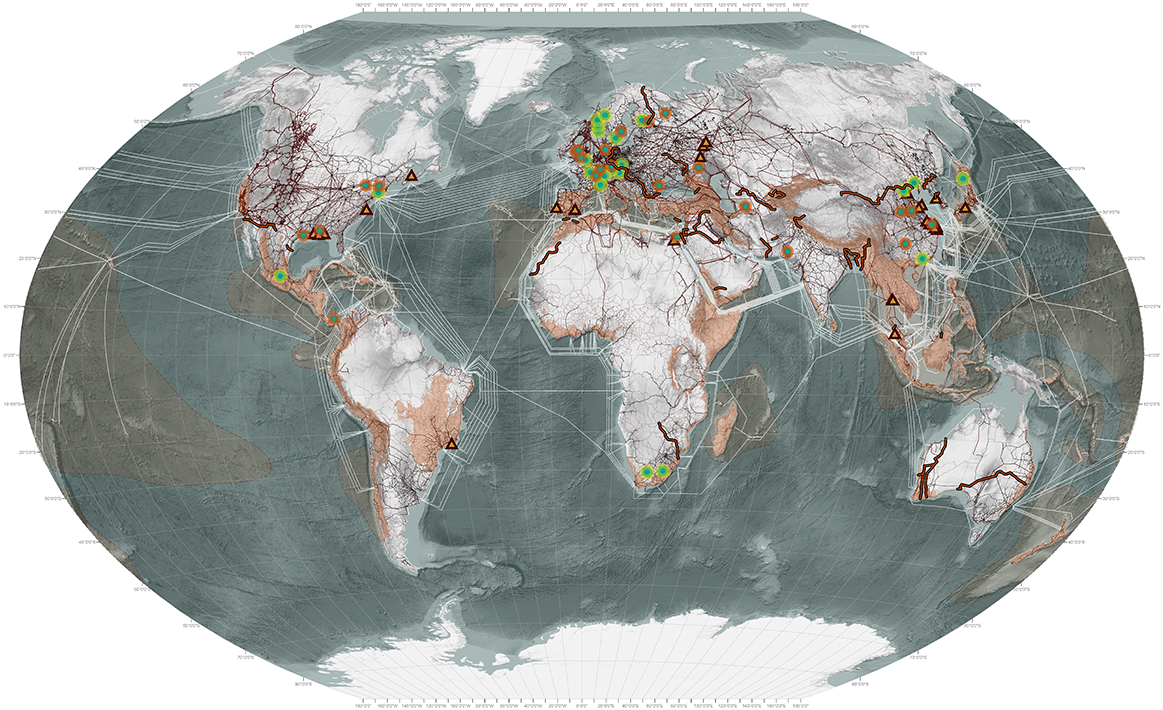In architectural discourse a megastructure is a large building which absorbs multiple functions; becoming something like a city unto itself. Here megastructures are simply registered as very large scale engineering works; canals, tunnels, bridges, walls, cables and pipes. Seen collectively these individual structures are part of the 21st century megastructure par excellence: 'planetary urbanization'. Although for reasons of graphic clarity we have not shown them, the megastructure of global urbanization also includes large scale earth works, dams, landfill sites, levees, berms, seawalls and land reclamation projects.
Planetary urbanization depends upon the world's network of ports, airports, and rail lines and roads. Over 64 million kilometers of road and one million of railway track bind over 4,000 cities, 44,000 airports and almost 5,000 ports into a global network for the movement of people and goods. With over 1.2 billion cars, 40,000 airplanes, 50,000 merchant ships and millions of freight trains all travelling as quickly as they can, the earth has never in its history seen so much movement. This mechanical frenzy is now complimented by the post-industrial infrastructure of cables and satellites enabling words and images to move close to the speed of light.
These networks of global connectivity are impressive but from the perspective of other species they generally represent fatal barriers. The challenge now is to add a new global network of green infrastructure so that all species can more easily migrate in accordance with the pressures of a rapidly changing climate. The beginnings of such a global green infrastructure network can be seen on the Global Landscape Connectivity Projects map.
1. Submarine Cables
TeleGeography: authoritative telecom data, "Submarine Cable Map," https://www.telegeography.com/telecom-resources/submarine-cable-map/index.html (accessed December 2, 2014). Data made available under the Creative Commons Attribution-NonCommercial-NoDerivs 3.0 Unported License: https://creativecommons.org/licenses/by-nc-nd/3.0/.
2. Pipelines (Natural Gas and Oil)
Jeff Blossom, "Global Oil Pipelines," Harvard Map Collection, Harvard College Library, http://worldmap.harvard.edu/data/geonode:global_oil_pipelines_7z9 (accessed November 17, 2014).
Martin, "Natural Gas Pipelines in Europe, Asia, Africa & Middle East," http://opendatacommons.org/licenses/by/1-0/ (accessed November 17, 2014). Data made available under the ODC Attribution license: http://opendatacommons.org/licenses/by/1-0/.
3. Hotspots
Critical Ecosystem Partnership Fund, "The Biodiversity Hotspots," http://www.cepf.net/resources/hotspots/pages/default.aspx (accessed July 1, 2014). Data made available under the Creative Commons BY-SA 4.0 License: https://creativecommons.org/licenses/by-sa/4.0/legalcode.







